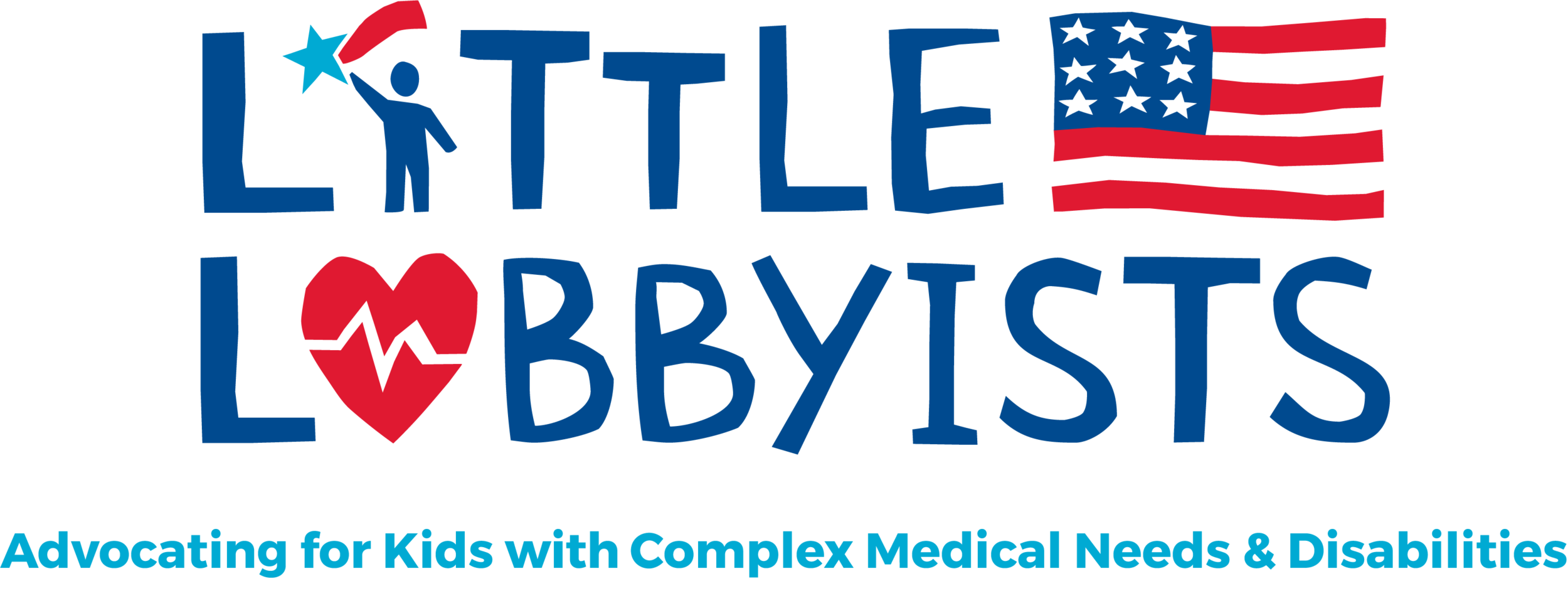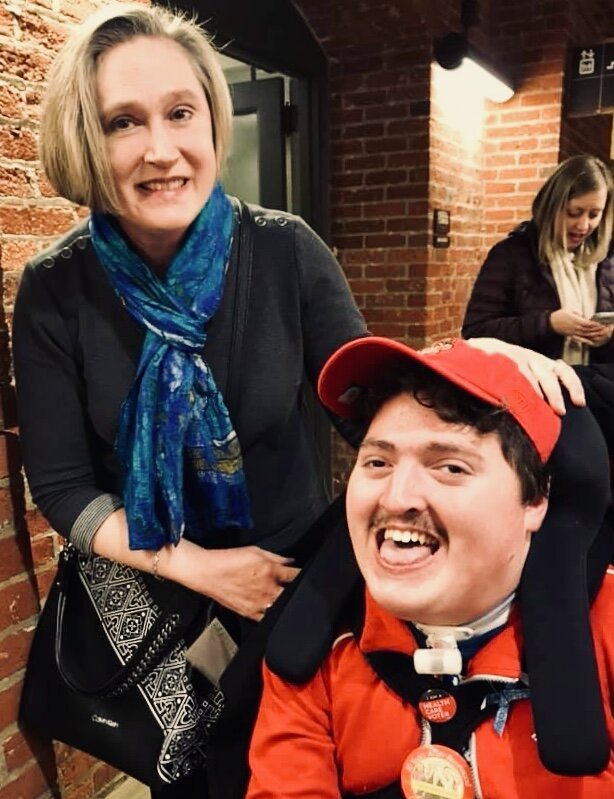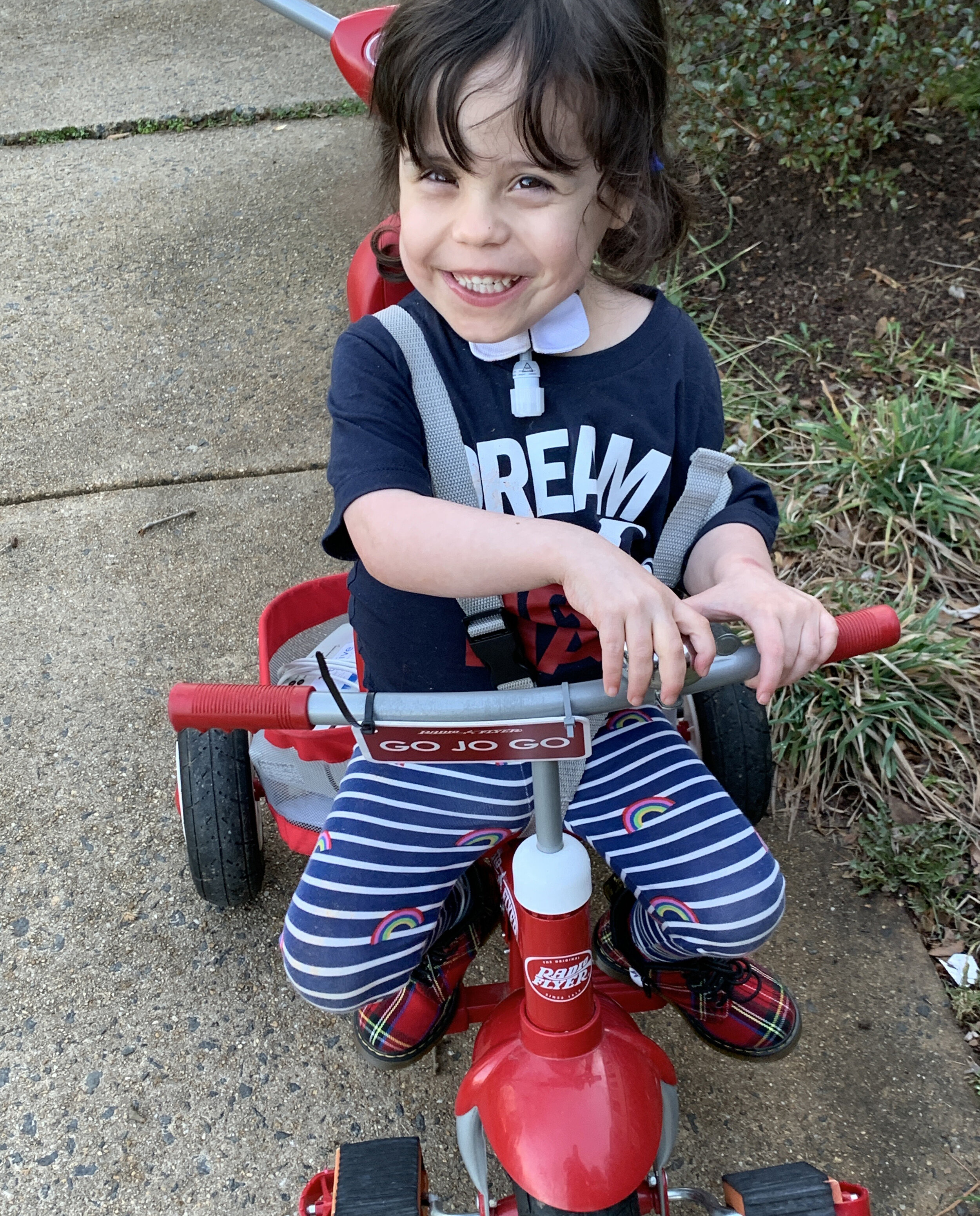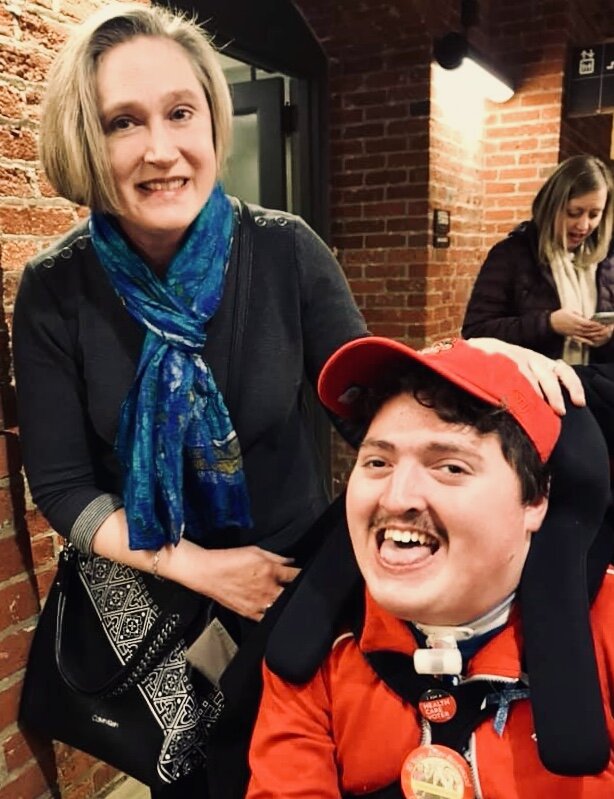The cover of Kelley’s book, white and blue lettering on a bright green color gradient. To the right is a color photo of Kelley, a white woman with red hair who wears glasses and poses with her arms folded over a stack of books.
Kelley Coleman is the mom to two amazing boys, one of whom has multiple disabilities (including an as-yet-undiagnosed genetic syndrome, cerebral palsy, autism, CVI, epilepsy, and more). Her book Everything No One Tells You About Parenting a Disabled Child: Your Guide to the Essential Systems, Services, and Supports stems from her own experience, giving parents the tools to spend less time navigating stuff and more time loving their kids exactly as they are.
This honest and relatable book is a roadmap to parenting a disabled child, covering all the essential topics we struggle with: diagnosis, school, doctors, insurance, financial planning, disability rights, and life as a parent caregiver. And there are templates you can use! And tons of links to resources in the appendix!
Kelley’s empathy shines through, page after page. As a reader, I never felt that she was telling me how I should be doing anything. Rather, her voice was like the spirit guide to parenting I’ve always wanted, telling me how I could do all the hard things, making suggestions and holding my hand. After 20+ years as a parent-caregiver, I still don’t know what I’m doing half the time, but I keep trying. And that’s one of Kelley’s messages to our community–keep going, try and fail, and try again. You can do it.
Black & white photo of a younger Kelley and her infant son Aaron. Their faces are in profile. She is kissing his forehead.
JS: Clearly, this book arose from your personal experiences struggling with the system, but was there a particular "aha!" moment when you realized, I have to write a book?
KC: I think all parents of kids with disabilities have been told we should write a book. I never thought I would write a book about how to do all of the stuff - it just sounded so boring. But, after a long night with Aaron having medical issues and none of us getting much sleep, I hit a wall. I realized that the only way we got through everything was by knowing how to do all of the stuff. That day, I realized that I needed to write the book. I wanted everyone to have access to the information of how to tackle the paperwork and the planning - the stuff that we all have to learn from the ground up, and that our kids depend on, and that is just so overwhelming. I realized right away that it was the opposite of boring - it’s life-changing.
JS: One of the things I loved about this book was your honesty: that you're still learning. Of all the topics you covered, in which area, personally, do you feel you're succeeding right now? In which do you struggle the most?
KC: Because I’m still learning every day, that answer will change every day. Today I feel like I’m succeeding with the social services piece. I just sent in our annual mountain of paperwork, and have found ways for our social service system to spend less money getting better supports for my son. That feels great. And, where am I struggling the most? The disability rights and advocacy piece is still a big learning curve for me. I’m always working on the balance between being my son’s advocate and teaching him to advocate for himself. His communication is emerging, and I find that I need to take more time to follow his lead and to build self advocacy into every part of his life. It would often be faster for me to power through, but then I’m not teaching him. The more I slow down, the more he teaches me.
JS: You emphasize the joy of raising disabled children, which is so wonderful! If books are surrogate children, as some say they are, writing which part of the book gave you the most joy?
Aaron, who wears glasses and has a medal on a ribbon around his neck, raises his hands up in triumph. He is in a classroom with a screen behind him that shows gold confetti.
KC: Writing a book - just like raising a child - is all the things. So much joy - and also every bit of the ups and downs that bring you to that joy. Connecting with leaders in the disability community was an amazing highlight. These are people I’ve looked up to for years, and when they said yes to being interviewed, I was humbled and appreciative. If Judy Heumann invites you to her house, you say yes. I was so fortunate to be able to spend time with her in person before she passed.
JS: What are the three main takeaways you'd like families to absorb from this book?
KC: It’s hard to choose three. But since you asked:
Learn about disability from disabled people. It shouldn’t be revolutionary to seek firsthand experience, but too often we forget that piece. When we learn from disabled people, we connect to a community and find role models to follow.
Caregiving is a job. All of this paperwork and planning may never be fun. You get better at it. You set up systems. And that allows you the space to be a parent, to enjoy your child, and to separate the mountains of paperwork from the fun of parenting.
Connect with other parents in this situation. We need to stop reinventing the same wheels. Chances are someone has done this before and can show you a better way. And, when you learn a better way, share that with everyone you know. We’re in this together.
Kelley Coleman is a feature film development executive turned author and advocate for individuals with disabilities and parent caregivers. She serves on committees for Children’s Hospital Los Angeles, the Los Angeles Unified School District, and Canine Companions. She lives in Los Angeles with her husband, two boys, and her son’s trusty service dog. Learn more about Kelley by visiting her website and following her on Instagram and Facebook.















![Ron Carlson [image description: A white-appearing man speaks at a lectern with a microphone]](https://images.squarespace-cdn.com/content/v1/59d8124080bd5eadd869b8b7/1624550950455-N0KN4HDRPN6SKZ07K9V7/Ron-Carlson-1030x579.jpg)
![A meeting of the Maryland Regional Direct Services Collaborative [image description: A large group of people sit at tables arranged in a square in a community college meeting room.]](https://images.squarespace-cdn.com/content/v1/59d8124080bd5eadd869b8b7/1624551140263-LE980FUOR10UQ8OPJEAA/Newsletter+-+November+VIP+Luncheon+Picture.JPG)

![“Woodlawn Lake, Early Autumn,” Sennelier Oil Sticks and Cold Wax Painting on Wood Panel, 10x10 inches, 2020. [image description: Impressionist techniques depict a pond with vegetation surrounding it, tall trees to the right, and clouds in the sky upper left. Brushstrokes are prominent.]](https://images.squarespace-cdn.com/content/v1/59d8124080bd5eadd869b8b7/1620918597845-X6KK7KN6L1SGT7C0XZUT/Woodlawn+Lake-Early+Autumn.jpeg)
![“Progress,” Pen and Ink Drawing, White gel pen, Artgraf ocher, graphite, and white washes, Micron colored pens, on Stonehenge Archival Kraft Paper, 11x14 inches, 2020. [image description: Construction equipment in yellow & brown in foreground, alongside fence. Telephone wires above, and storefront visible in background.]](https://images.squarespace-cdn.com/content/v1/59d8124080bd5eadd869b8b7/1620918618991-PGS1TQ37NPVMLZG075V8/Progress_AWeddle.jpeg)


![Maya’s daughter Ruby. [image description: A young Black girl with long, curly black hair wears pink sunglasses while she makes notes with a pen on a blue pad.]](https://images.squarespace-cdn.com/content/v1/59d8124080bd5eadd869b8b7/1617904561702-WFNT20BASIDA489IZIQ4/Ruby+B-Z.jpg)

![Jeneva & her son Rob [image description: A mom with short blonde hair wears a blue scarf & grey dress. Her son is seated in a wheelchair with an orange shirt & orange baseball cap.]](https://images.squarespace-cdn.com/content/v1/59d8124080bd5eadd869b8b7/1617904825968-F8U24NCW3H4ZLBEXSWNK/JenevaAndRobert._JWJjpeg.jpeg)
![Ande Kolp (third from left) and her children. [image description: A white-appearing family poses in the living room of their home. Five people stand in a line, arms linked. They wear brightly colored t-shirts: 3 women at center, 2 men on either end.]](https://images.squarespace-cdn.com/content/v1/59d8124080bd5eadd869b8b7/1616690192048-48Q9UDXJ9IHYKOSSKPYY/ande+kolp+and+kids.jpg)


![Brynleigh Shillinger [image description: A young girl with dark hair and a purple hair bow poses in a wicker outdoor chair with teal cushions. She holds a purple sign that reads “Brynleigh’s Act, SB225, HB370, #Seizure Safe Schools MD.”]](https://images.squarespace-cdn.com/content/v1/59d8124080bd5eadd869b8b7/1614877315486-42JYPTE52UMFZW9WLF9M/Brynleigh.jpg)
![The Shillinger Family. [A father poses in white shirt and purple tie, a mom holds her daughter—both mother and daughter are wearing deep blue clothing.]](https://images.squarespace-cdn.com/content/v1/59d8124080bd5eadd869b8b7/1614877457541-MYFDHQ3CT62D2KDN3XFA/Shillinger+Family.jpg)

![Jeneva & her son Rob [image description: A mom with short blonde hair wears a blue scarf & grey dress. Her son is seated in a wheelchair with an orange shirt & orange baseball cap.]](https://images.squarespace-cdn.com/content/v1/59d8124080bd5eadd869b8b7/1614877746207-JTGO1B3ZGKXQUXWZYMCO/JenevaAndRobert._JWJjpeg.jpeg)

![The Silverman-Stern Family: Annabelle, Sophie, Ray & Amy [image description: A family poses at their front door, framed by green leaves of adjacent bushes.]](https://images.squarespace-cdn.com/content/v1/59d8124080bd5eadd869b8b7/1608745259829-CKXIKCK461D299LEBM8Y/silverman_stern+family.jpeg)
![Jeneva & her son Rob [image description: A mom with short blonde hair wears a blue scarf & grey dress. Her son is seated in a wheelchair with an orange shirt & orange baseball cap.]](https://images.squarespace-cdn.com/content/v1/59d8124080bd5eadd869b8b7/1608744874116-KN5JUNMOM5SP2PLB32M6/JenevaAndRobert._JWJjpeg.jpeg)

![Anian & his sisters. [image description: Standing in front of a fountain are two young Black girls with cornrow braids pose on either side of a young Black boy with Down Syndrome.]](https://images.squarespace-cdn.com/content/v1/59d8124080bd5eadd869b8b7/1608139885547-E6GRNPKOTZVJOBOW37TU/5BF24EE5-A9CB-453F-9524-0C36FBC39D5F_1_201_a.jpeg)
![Cover of A Friend Like Anian. [image description: Illustration of a young Black boy with Down Syndrome posed in front of neighborhood houses.]](https://images.squarespace-cdn.com/content/v1/59d8124080bd5eadd869b8b7/1608139924293-B5XOI2JTVYW4GAJEE7Q4/Our+book+cover.jpg)
![Cover of A Friend Like Anian: First Day of School. [image description: Illustration of a Black mom with glasses and short light hair hugging her son with Down Syndrome in a child’s bedroom.]](https://images.squarespace-cdn.com/content/v1/59d8124080bd5eadd869b8b7/1608139947544-FI9PY3O0TF8ZNCKYX2QV/Cover+The+First+Day+of+School.jpg)


















